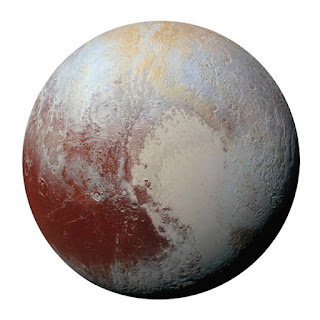The shuttle played out a flyby of the bantam planet and its moons in July 2015, and the experiences assembled then are as yet reworking almost all that researchers comprehend about Pluto.
The bantam planet exists on the edge of our planetary group in the Kuiper Belt, and it's the bigger of the many frozen objects there circling a long way from the sun. The frosty world, which has a normal temperature of negative 387 degrees Fahrenheit (negative 232 degrees Celsius), is home to mountains, valleys, icy masses, fields and cavities. If you somehow managed to remain on a superficial level, you would see blue skies with red snow.
Another photograph investigation showed a rough district on Pluto that doesn't resemble some other piece of the little world - - or the remainder of our vast area.
"We found a field of extremely huge cold volcanoes that seem as though whatever else we have found in the planetary group," said concentrate on creator Kelsi Singer, senior exploration researcher at the Southwest Research Institute in Boulder, Colorado.
A review enumerating the discoveries distributed Tuesday in the diary Nature Communications.
The locale is found southwest of the Sputnik Planitia ice sheet, which covers an old effect bowl extending 621 miles (1,000 kilometers) across. To a great extent made of rough water ice, it's loaded up with volcanic arches. Two of the biggest are known as Wright Mons and Piccard Mons.
Wright Mons is around 13,123 to 16,404 feet (4 to 5 kilometers) tall and ranges 93 miles (150 kilometers), while Piccard Mons comes to about feet 22,965 feet (7 kilometers) high and is 139 miles (225 kilometers) wide.
Wright Mons is viewed as comparable in volume to the Mauna Loa fountain of liquid magma in Hawaii, which is one of the greatest volcanoes on Earth.
A portion of the arches saw in the pictures combine to shape considerably greater mountains, Singer said. However, what might have made them? Ice volcanoes.
Ice volcanoes have been noticed somewhere else in our nearby planet group. They move material from the subsurface up to the surface and make new landscape. For this situation, it was water that immediately became ice once it arrived at the bone chilling temperatures of Pluto's surface.
"The manner in which these elements look is altogether different than any volcanoes across the nearby planet group, either frigid models or rough volcanoes," Singer said ."They framed as mountains, however there is no caldera at the top, and they have enormous knocks all over them."
Deeply, researchers have long accepted that the planet needed a lot of inside warming, which is expected to prod volcanism. To make the district Singer and her group examined, there would have been a few emission locales.
The examination group likewise noticed that the region has no effect cavities, which should be visible across Pluto's surface, which recommends that the ice volcanoes were dynamic generally as of late - - and that Pluto's inside has more lingering heat than anticipated, Singer said.
"This implies Pluto has more inward hotness than we naturally suspected it would, and that implies we don't completely comprehend how planetary bodies work," she said.
The ice volcanoes presumably shaped "in different episodes" and were reasonable dynamic as of late as 100 million to 200 million years prior, which is youthful topographically speaking, Singer added.
If you somehow happened to observe an ice well of lava eject on Pluto, it could appear to be somewhat unique than you anticipate.
"The frigid material was presumably to a greater degree a slushy blend of ice and water or more like toothpaste while it streamed out of a volcanic vent onto the outer layer of Pluto," Singer said. "It is so cold on the outer layer of Pluto that fluid water can't stay there for a really long time. Now and again, the progression of material framed the enormous arches that we see, as well as the uneven landscape tracked down wherever around here."
At the point when New Horizons flew by this district, the group saw no current ice spring of gushing lava movement, yet they were simply ready to see the region for about a day. It's conceivable that the ice volcanoes are as yet dynamic.
"They could be like volcanoes on Earth that stay torpid for quite a while and afterward are dynamic once more," she said.
Pluto once had a subsurface sea, and finding these ice volcanoes could propose that the subsurface sea is as yet present - - and that fluid water could be near the surface. Joined with the possibility that Pluto has a hotter inside than recently accepted, the discoveries bring up captivating issues about the bantam planet's likely livability.
"There are still a great deal of difficulties for any life forms attempting to make due there," Singer said. "They would in any case require a few wellspring of constant supplements, and assuming the volcanism is verbose and consequently the hotness and water accessibility is variable, that is some of the time extreme for creatures too."
Examining Pluto's charming subsurface would require sending an orbiter to the far off world.
"On the off chance that we sent a future mission, we could utilize ice-entering radar to peer straightforwardly into Pluto and perhaps even see what the volcanic pipes resembles," Singer said.
Similar Topics
A Vast Secret: Astronomers Catch Kicking the Bucket Star Blowing Smoke Rings
New Clues to Earth's Formation From Ancient Helium Leaking From the Planet's Core

Comments
Post a Comment